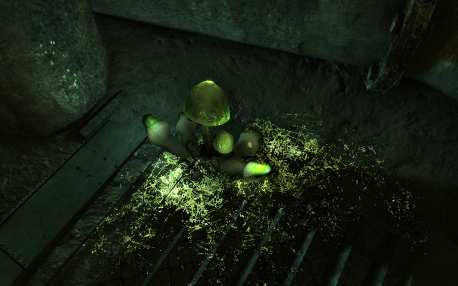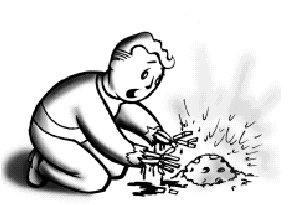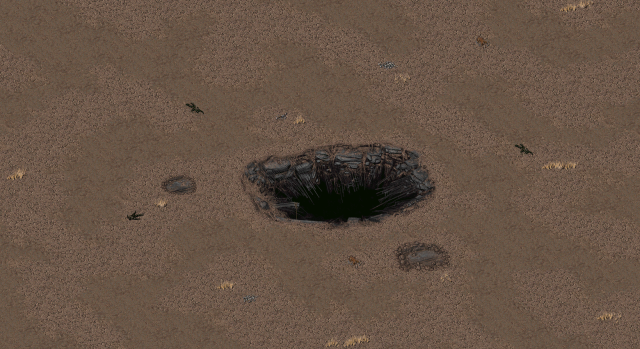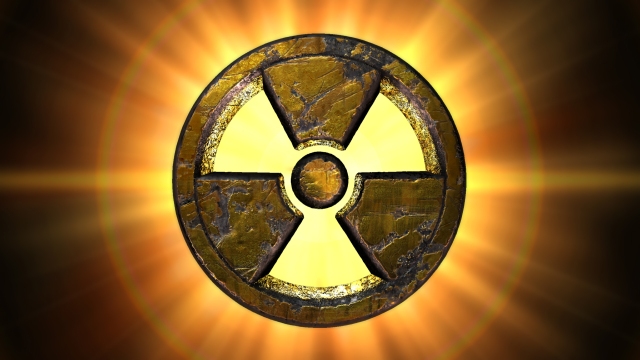
You can’t have a post-nuclear setting without radiation. Many films overlook this crucial aspect or at most offer a token Geiger counter scene (She Wolves of the Wasteland). This is largely because radiation cannot be seen, felt, or heard. Generally, special equipment is required to detect the presence of radiation. While this element of world building is often overlooked in film, radiation serves as an important gameplay mechanic in the majority of post-nuclear video games. However, with gamification comes new challenges. Radiation typically does not kill outright. Even several lethal doses will not result in immediate death. Therefore, because radiation attacks the body slowly, game developers have approached this mechanic in a variety of ways.
To further explore this mechanic, we’ll be analyzing three game series that make extensive use of radiation.
- Metro 2033
- S.T.A.L.K.E.R.
- Fallout

The Geiger counter in Metro 2033 is primarily used for immersive world building. Small set pieces such as bioluminescent mushrooms or pools of bubbling green slime will cause the Geiger counter to tick. These pockets of radiation are mostly harmless, though Artyom can die if he stands in a hotspot for a few minutes. Although subtle, this gameplay mechanic immerses the player into the setting. Without radiation, the world of Metro 2033 could be mistaken for a sci-fi setting similar to Gears of War, especially since Moscow’s surface is considered poisonous rather than radioactive. This is why so many post-apocalyptic movies have an obligatory Geiger counter scene: it puts the audience in a survivalist mindset. The Metro games take this a step further, subtly reminding the player that the world above the tunnels is not like the world in the postcards.

Though technically not post-nuclear, fans of the S.T.A.L.K.E.R. franchise are constantly aware of their radiation exposure. Contrary to a handful of contaminated puddles and mushrooms in post-nuclear Moscow, the Zone is positively covered with fields of radiation. Players who wander into these hot spots will find their vision distorted by grey TV static.
Radiation damage is pretty simple: the more radiation you’ve absorbed, the faster your health decreases. Radiation can be removed either with a radiation absorbing artifact or a dose of anti-rad. Because artifacts drain radiation slowly and anti-rad is somewhat rare, players are forced to respond quickly after absorbing deadly amounts of radiation.

Although the Zone’s radioactive hotspots (and anomalies) seem like a nuisance, they actually encourage exploration. Artifact hunting aside, anomalies and pockets of radiation act as landmines, encouraging the player to take the long way (usually ending up at a lootable location), rather than risk wasting resources or instant death.
Moreover, S.T.A.L.K.E.R. encourages a high risk/ high reward style of gameplay when dealing with artifacts. Although artifacts grant stalkers special abilities, they also emit deadly amounts of radiation. Before obtaining high tier anti-radiation artifacts, players will occasionally be forced to balance their health, elemental resistance, carry weight, and radiation levels. Having artifacts emit radiation was a brilliant idea and one that makes the S.T.A.L.K.E.R. series all the more satisfying and rewarding.

Finally, there’s the Fallout franchise. Radiation sickness has been a gameplay mechanic since the first Fallout, but it originally didn’t effect much. In the first game, there were only two ways to get irradiated: Get smacked by a glowing one or wander into The Glow.

The original Fallout has the most complex take on radiation sickness, requiring a chart to fully understand what it does. Every part of the character is effected: HP, healing, and SPECIAL (with skills as a result). If either HP or any S.P.E.C.I.A.L. attribute drops to zero because of radiation sickness, the character will die. However, as I said previously, I don’t think radiation was used to its full potential in the original Fallout. Two doses of Rad-X makes the player completely immune to radiation, giving them 24 hours to explore The Glow without worrying about any side effects. Even if the player took a few points of radiation damage on arrival, they can use a single Rad-Away to instantly cure themselves. Allowing the player to reach 100% radiation resistance detracted from the danger of The Glow as the lore (and environment) shows that even Brotherhood Paladins have died due to the intense radiation exposure.

Fallout 3 streamlined the mechanic of radiation sickness. Instead of effecting several variables, radiation sickness only lowers endurance (at minor sickness), agility (at advanced sickness), strength (at critical sickness) and finally caused death at 1000 rads. Additionally, radiation was far more present in Fallout 3 than previous games in the franchise. The Lone Wanderer could not eat or drink without absorbing at least a few rads. Additionally, radiation resistance was capped at 85%, making it challenging to approach areas like Vault 87.
As a side note, rads are a real (if outdated) unit of measuring radiation. 1000 rads delivered in a short period of time will usually cause death.
With Fallout 3 and New Vegas came special perks associated with radiation sickness. These perks are often overlooked as the majority of players want to keep their rads as low as possible. However, the brave few who uses these bonuses will find their gameplay dramatically shifts toward min-maxing.
- Rad Regeneration: Offers the player free healing of crippled limbs in exchange for advanced radiation sickness (-2 EN, -1 AG). This perk comes free with the “Wasteland Survival Guide” quest, but is lackluster compared to admantium skeleton, which decreases limb damage by 50%. Perhaps this perk was ahead of its time. It would have been great for survival mode in New Vegas (as rare doctors bags are required to heal limbs), but in a game where a single stimpack instantly heals crippled limbs, this is a useless perk.
- Rad Child: This perk is where high risk/high reward shines through. Each level of radiation sickness increases health regeneration. In exchange for minor radiation sickness (-1 EN), player are treated to +2 health per second. At advanced sickness, players receive +4 health per second. Again, this is often overlooked simply because it relies on radiation, which brings S.P.E.C.I.A.L. penalties. However, by utilizing Wasteland outfits (which provide +1 EN, +1 AG) the effects of advanced sickness are practically nullified, while the Courier still benefits from extreme HP regeneration. While this perk should bring a lot of risk, it actually provides far more protection than power armor or a higher damage threshold while still allowing players to travel at maximum speed.
- ATOMIC: This perk grants players a faster run speed, +2 strength, and +2 damage threshold while being irradiated. Additionally, action points regenerate much faster based on level of radiation sickness. This synergizes amazingly well with Rad Child. The challenge is that the best parts of the perk are only available while being irradiated. Luckily, New Vegas has coyote steaks, which irradiate the player over time and whose effects stack. If the Courier should buy coyote steaks at every opportunity, they will become more powerful than any wastelander could possibly imagine.
Although overlooked, New Vegas’ radiation perks are definitely worth the penalties they bring, especially when combined with wasteland outfits and the Travel Light perk.

Most recently, there is Fallout 4 and Fallout: Shelter where the mechanic of radiation sickness was streamlined once again. Radiation sickness now merely reduces maximum health by 1% per 10 rads (making 1000 rads still lethal). This eliminates the complexities of the S.P.E.C.I.A.L. system as a whole and reduces roleplaying opportunities.
At a first glance Fallout 4 seems like it moved away from the aspect of radioactivity. Although the game moved away from player interaction with radiation, it expanded on NPC interaction in the form of weapons that utilize radiation damage. These weapons reduce the max health of an enemy, making it more difficult (if not impossible) for them to heal. What’s interesting in this new gameplay element is that some enemies are immune to radiation while others are highly resistant. This is a big shift from Fallout 3, where all NPCs were immune to radiation and could approach the door of Vault 87 without any trouble.

Overall, each game (even within the same franchise) deals with radiation differently. It’s a difficult feature to include in a game and it’s even harder to get right. There’s no right or wrong answer to the inclusion of radiation sickness in a video game or movie. Metro 2033 uses radiation merely to set the tone, while S.T.A.L.K.E.R. uses radiation to make players think about resource management and navigation, and the gameplay mechanics of the Fallout franchise continue to mutate in entirely new directions. Radiation is a necessary part of the post-nuclear atmosphere and I hope game developers continue to experiment with this genre specific gameplay mechanic.

How would you like to see radioactivity and radiation sickness used in video games? Tell us in the comments!

Great post! I really enjoy the injection of possibility provided by “radiation” in a lot of the games you reference: the post apocalyptic genre is inherently bleak and empty, so some degree of mysticism and magic can be a welcome relief! And hey, who doesn’t love ogling radioactive monsters in games like Fallout?
LikeLiked by 1 person